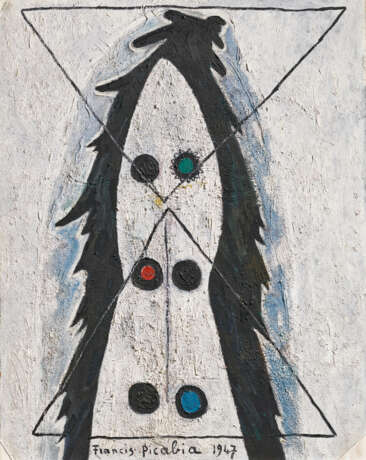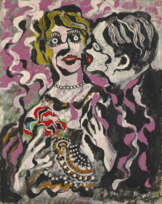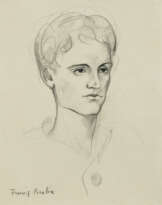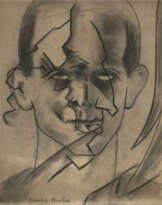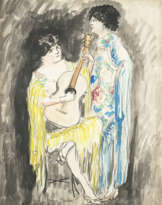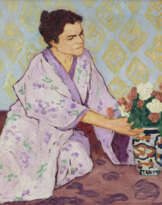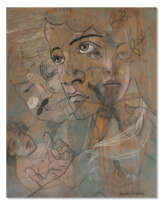ID 929400
Los 9 | Francis Picabia (1879-1953)
Schätzwert
€ 700 000 – 1 000 000
Untitled
signé et daté 'Francis Picabia 1947' (en bas au centre)
huile sur carton
92 x 73 cm.
Peint en 1947
signed and dated 'Francis Picabia 1947' (lower centre)
oil on board
36 1/4 x 28 3/4 in.
Painted in 1947
Provenance
Galerie René Drouin, Paris (avant 1949).
Georges et Claude Pompidou, France (avant 1973).
Collection particulière, France (par descendance); vente, Sotheby's, Paris, 2 juillet 2008, lot 3.
Acquis au cours de cette vente par le propriétaire actuel.
Literature
M. L. Borràs, Picabia, Paris, 1985, p. 535, no. 869 (illustré, p. 491, no. 1116).
W. A. Camfield, B. Calté, C. Clements et A. Pierre, Francis Picabia, Catalogue raisonné, 1940-1953, Bruxelles, 2022, vol. IV, p. 368-369, no. 1981 (illustré en couleurs, p. 369).
Exhibited
Paris, Galerie René Drouin, 50 ans de plaisirs, mars 1949.
Paris, Palais des Congrès, Picabia, Dandy et Héraut de l'art du XXe siècle, novembre 1980-janvier 1981, no. 38.
Bruxelles, Musée d'Ixelles, Picabia, mai-août 1983, no. 85 (illustré).
Dusseldorf, Städtische Kunsthalle; Zurich, Kunsthaus et Stockholm, Moderna Museet, Francis Picabia, octobre 1983-mai 1984, p. 182, no. 146. (illustré, p. 138).
Madrid, Salas Pablo Ruiz Picasso et Barcelone, Centre Cultural de la Caixa de Pensions, Francis Picabia, Exposicio´n antolo´gica, janvier-mai 1985, p. 371, no. 162 (illustré en couleurs, p. 211; titré 'Composition').
Cajarc, Maison des Arts Georges Pompidou, "Autour d'une collection", Le Président et Madame Georges Pompidou, juillet-août 1994.
Special notice
Artist's Resale Right ("droit de Suite").
If the Artist's Resale Right Regulations 2006 apply to this lot, the buyer also agrees to pay us an amount equal to the resale royalty provided for in those Regulations, and we undertake to the buyer to pay such amount to the artist's collection agent.
ƒ: In addition to the regular Buyer’s premium, a commission of 5.5%
inclusive of VAT of the hammer price will be charged to the buyer.
It will be refunded to the Buyer upon proof of export of the lot
outside the European Union within the legal time limit.
(Please refer to section VAT refunds)
Post lot text
« Chaque tableau est pour moi un drame, passant par tous les stades de ma production antérieure, formes, transparences, superposés, pour continuer plus loin et aboutir à cet instant fugitif, mais extatique où je sais que je tiens cet insaisissable qu’est le réel »
Francis Picabia
Comme la plupart des créations de Picabia postérieures à 1945, notre œuvre surprend par la simplicité de sa composition. Sur un fond blanc se détache une forme fantomatique verticale, dessinée d’un épais trait de noir et auréolée de bleu. Le contour travaillé de cette silhouette évoque une fourrure animale ou une coiffure hirsute, détail qui laissent imaginer la proximité avec un animal sauvage et insolite. Six taches circulaires, quelques-unes décorées, agrémentent de manière symétrique cette figure. Monstres aux multiples paires d’yeux, simplification extrême d’un sujet humain ou abstraction total ?
C’est à la fin de la guerre que s’amorce cette réorientation complète de la peinture de Picabia vers l’abstraction et la définition de ce que Gabrielle Buffet, sa première épouse, décrit comme « un genre totalement nouveau avec un renouvellement complet dans le paroxysme ». L’après-guerre voit un tournant plus général de la peinture en France, fortement marquée par une réaction aux représentations traditionnelles. L’exposition Art Concret organisée en juillet 1945 par la Galerie Drouin à Paris en est un signe, la peinture s’oriente vers une non-figuration radicale sans aucun lien avec le monde visible.
Picabia abandonne le réalisme populaire de la guerre pour une forme personnelle d’abstraction. Il expose à la galerie Denise René, trente–cinq oeuvres résolument abstraites et qualifiées par Picabia de sur-irréalistes ; le choix de ce terme indiquant la volonté de Picabia de se démarquer du Surréalisme. Picabia expose en 1946 au Salon des Réalités nouvelles et montre cinq toiles de sa manière abstraite au salon des Surindépendants. Pour lui, ce salon est l’endroit où « l’on trouve le plus d’activité et un certain élan véridique ».
Certains critiques tentent d’expliciter cette démarche en la qualifiant d’« Abstraction Psychique » qui prendra un an plus tard le nom de « Non-figuration Psychique ». Picabia se risque à traduire ce qui n’a pas de forme, mais qui cependant existe. C’est la transposition plastique de son monde intérieur et c’est en ce sens seulement que l’on peut parler d’abstraction psychique. L’œuvre Viens avec moi là bas (1948), au même titre que la présente œuvre, est un excellent exemple de cette abstraction qui célèbre à la fois l’immense liberté intellectuelle de l’artiste et sa critique ironique de l’art.
Picabia se rapproche alors d’un groupe d’artistes liés à l’Abstraction Lyrique qui partage cet élan nouveau. Autour d’Henri Goetz et Christine Boumeester, Francis Bott, Jean Atlan, Raoul Ubac mais aussi Matta, Soulages, Schneider, Tal Coat et Hartung partagent cette conception picturale et aspirent comme Picabia au spectacle du rêve et à la force de l’instinct. Ce groupe d’artistes surindépendants devient le laboratoire où s’expérimente un compromis entre le Surréalisme et l’Art Abstrait. Les œuvres de cette mouvance ont comme caractère commun l’absence d’unité formelle et la présence d’un thème abstrait structuré de façon équilibrée dans une composition plutôt simple, parfois biomorphique où la couleur ne joue qu’un rôle secondaire. Le peintre soustrait les éléments matériels de leur contexte habituel et des catégories significatives attendues pour les transformer en objets purs. Picabia voit dans ce geste pictural une façon plus directe et impulsive de transcrire un état intérieur. Selon l’artiste, « le public ne doit pas chercher un souvenir 'photographique' d’une impression visuelle ou d’une sensation, mais il doit les regarder comme une tentative pour exprimer le plus pur de la réalité abstraite de la forme et de la couleur considérées en elles-mêmes. »
Dans cette toile minimaliste, Picabia a limité la représentation à cette figure mystérieuse. Sa forme oblongue et primitive rappelle esthétiquement la statuaire africaine brute et mystique. Certaines des peintures de la fin de la guerre reprennent en effet des motifs inspirés de sources préhistoriques et d’une iconographie primitive (Je vous attends, 1948 ou Pistil, 1946), mais ici, l’allusion reste légère. Les contours sont simplifiés, les formes inventées et l’absence de repère significatif laisse libre court à ce que Picabia nomme l’expression pure de « la réalité abstraite de la forme et de la couleur ». Malgré tout, la forme évoque un être fragile, peut-être tendre, tout en restant très énigmatique. L’artiste fait appel à nos sens mais également à notre inconscient pour regarder et ressentir ce tableau car l’absence de détail et l’indétermination des motifs picturaux concourent à rendre cette œuvre particulièrement impénétrable et déconcertante.
Par ailleurs, Picabia utilise la peinture en pleine pate et obtient d’étonnants effets de matière. Alternances de matières mates et satinées, matières mouchetées et marbrées, les abstractions de l’artiste présentent une texture très travaillée, perceptible tant à l’œil qu’au toucher. Dans la présente œuvre, la matière est empâtée et évoque des surfaces rugueuses (d’une paroi rocheuse ?). La palette utilisée est réduite aux couleurs primaires qui – avec le vert – sont appliquées en aplats, les zones colorées étant circonscrites par un entourage de noir. L’utilisation des couleurs est restreinte aux petits cercles qui animent cette forme blanche, telles des lumières, des boutons ou des petits yeux. Le fond est fait de touches denses où se mêlent le blanc et le bleu clair.
La présence de deux triangles disposés à l’opposé en forme de sablier complexifie la lecture du tableau. A cette époque, Picabia remanie souvent des œuvres plus anciennes et notamment en y superposant des formes schématiques. L’adjonction de ces lignes droites forme une sorte de cadre dans lequel le sujet central est circonscrit. Cet encadrement n’est pas sans rappeler l’œuvre majeure de Picabia, La Danse de Saint-Guy, 1919 (Musée national d’art moderne, Centre Georges Pompidou), une peinture transparente, sans toile ni matière picturale, réduite au seul dispositif, absurde, d’un cadre avec ficelles et étiquettes. La figure des deux triangles pointe-à-pointe formant des diagonales qui se croisent, ordonne et structurent la présente œuvre. Mais ces motifs triangulaires peuvent également être une référence sexuelle non explicite. En effet, le triangle du bas portant un trait vertical en son centre, pourrait-il être une symbolisation très primitive du sexe féminin mis en opposition au triangle de la partie supérieur qui – par l’absence de cette marque – se laisse deviner masculin.
En 1947, au moment où il réalise la présente œuvre, Picabia a soixante-huit ans et derrière lui quelques cinquante années mises au service de l’Art. La page de la figuration semble tournée et Picabia se jette à corps perdu dans un style nouveau. C’est la recherche d’un art plus riche en contenu dans une forme moins explicite. L’élan artistique doit chercher à fixer directement la sensibilité et l’instinct de l’artiste tout en faisant tomber les barrières entre ce dernier et le spectateur. Picabia déclare qu’il faut que le tableau soit « un moyen d’échange de nos sensibilités à l’état pur », qu’il soit l’expression de qu’il y a de plus vrai dans notre être intérieur.
Peut-être Picabia tente-il ici de réaliser un compromis moqueur entre l’Abstraction et le Surréalisme ? Peut-être reprend-il le thème du Monstre du Valais, créature hybride fantastique inspirée d’un fait divers suisse où un loup décime les troupeaux et dont il fit un dessin envoyé dans une lettre à ses amis Christine Boumeester et Henri Goetz en cette même année 1946 ? Ou peut-être cette composition fantasque à l’allure animale n’est-elle qu’une extériorisation du monde intérieur et des angoisses de l’artiste ? Cette figure totémique déconcertante semble une matérialisation très littérale de la proposition artistique de Picabia de questionner le rôle de l’Art et de l’artiste en explorant de nouveaux langages picturaux. Car pour le peintre, l'Art n'est pas considéré comme une reproduction de la nature mais plutôt comme l'expérience émotionnelle de l'artiste face à celle-ci, exprimée de façon subjective dans une synthèse de formes et de couleurs.
"Each painting is a drama for me, passing through all the stages of my previous production, forms, transparencies, overlaid, to continue further and reach that fleeting, but ecstatic moment where I know that I am holding onto that elusive thing that is reality."
Francis Picabia
As with most of Picabia's creations after 1945, this work surprises with the simplicity of its composition. A ghostly vertical form, drawn with a thick black line and haloed in blue, stands out against a white background. The worked contour of this silhouette evokes animal fur or a wild, unkempt hairstyle, a detail that suggests proximity to an unusual and wild animal. Six circular spots, some decorated, symmetrically embellish this figure. Are they monsters with multiple pairs of eyes, an extreme simplification of a human subject, or total abstraction?
At the end of the war, a complete reorientation of Picabia's painting towards abstraction begins, as well as the definition of what Gabrielle Buffet, his first wife, describes as "a totally new genre with a complete renewal in the paroxysm". The post-war period sees a more general turning point in painting in France, strongly marked by a reaction to traditional representations. The Art Concret exhibition organized in July 1945 by the Galerie Drouin in Paris is an example of this, as painting is moving towards a radical non-figuration with no connection to the visible world.
Picabia abandons the popular realism of the war for a personal form of abstraction. He exhibits thirty-five resolutely abstract works at the Denise René gallery, which Picabia qualifies as "sur-irrealist", the choice of this term indicating his desire to distance himself from Surrealism. Picabia exhibited in 1946 at the Salon des Réalités Nouvelles and showed five canvases in his abstract style at the Salon des Surindépendants. For him, this salon is the place where "the most activity and a certain truthful momentum" can be found.
Some critics try to explain this approach by describing it as "Psychic Abstraction" which a year later will be called "Psychic Non-figuration". Picabia ventures to translate what has no form but nonetheless exists. It is the plastic transposition of his inner world, and it is only in this sense that we can speak of psychic abstraction. The work Viens avec moi là bas (1948), as well as ours, is an excellent example of this abstraction that celebrates both the artist's immense intellectual freedom and his ironic critique of art.
Picabia then joined a group of artists associated with Lyrical Abstraction who shared this new momentum. Around Henri Goetz and Christine Boumeester, Francis Bott, Jean Atlan, Raoul Ubac, but also Matta, Soulages, Schneider, Tal Coat, and Hartung, they all shared this pictorial concept and aspired, like Picabia, to the spectacle of dreams and the power of instinct. This group of Surindependent artists became the laboratory where a compromise between Surrealism and Abstract Art was experimented. The works of this movement have the common characteristic of the absence of formal unity and the presence of an abstract theme structured in a balanced manner in a rather simple composition, sometimes biomorphic, where color plays only a secondary role. The painter extracts material elements from their usual context and expects meaningful categories to transform them into pure objects. Picabia sees in this pictorial gesture a more direct and impulsive way to transcribe an inner state.
"The public should not seek a 'photographic' memory of a visual impression or sensation, but should look at them as an attempt to express the purest abstract reality of form and color considered in themselves."
In this minimalist painting, Picabia has limited the representation to this mysterious figure. Its oblong and primitive shape aesthetically recalls African raw and mystical statuary. Some of the paintings from the end of the war indeed use motifs inspired by prehistoric sources and primitive iconography (Je vous attends, 1948 or Pistil, 1946), but here, the allusion remains light. The contours are simplified, the shapes invented, and the absence of significant reference leaves room for what Picabia calls the pure expression of "the abstract reality of form and color". Nevertheless, the shape evokes a fragile, perhaps tender being, while remaining very enigmatic. The artist appeals to our senses but also to our unconscious to look at and feel this painting because the lack of detail and the indetermination of the pictorial motifs contribute to make this work particularly impenetrable and disconcerting.
Picabia uses impasto paint to achieve astonishing material effects. Alternating between matte and satin textures, speckled and marbled surfaces, the artist's abstractions present a highly worked texture, perceptible both to the eye and to the touch. In our painting, the material is quite thick and evokes rough surfaces (of a rock wall?). The palette used is generally limited to primary colors which, along with green, are applied in flat areas, with the colored zones circumscribed by a border of black. The use of color is restricted to small circles that enliven this white form, like lights, buttons or small eyes. The background is made up of dense strokes where white and light blue mix.
The presence of two triangles arranged opposite each other in the shape of an hourglass complicates the reading of the painting. At this time, Picabia often reworks older works, notably by superimposing schematic forms. The addition of these straight lines forms a sort of frame in which the central subject is circumscribed. This framing is reminiscent of Picabia's major work, La Dance du Saint-Guy, 1919 (Musée d'Art Moderne du Centre Pompidou), a transparent painting, without canvas or pictorial material, reduced to the absurd device of a frame with strings and labels. The figure of the two triangles point-to-point forming diagonals that cross, orders and structures the painting presented here. But these triangular motifs can also be an implicit sexual reference. Indeed, the bottom triangle with a vertical line in its center could be a very primitive symbolization of the female sex opposed to the upper triangle which, by the absence of this mark, would suggest a masculine sex.
In 1947, at the time of the creation of this untitled work, Picabia was sixty-eight years old and had spent some fifty years in the service of Art. The page of figuration seems to have been turned and Picabia throws himself headlong into a new style. It is the search for a more content-rich art in a less explicit form. The artistic impulse must seek to directly capture the sensitivity and instinct of the artist while breaking down the barriers between the artist and the viewer. Picabia declares that the painting must be "a means of exchanging our sensitivities in their purest state," expressing what is most true in our inner being.
Perhaps Picabia is attempting to create a mocking compromise between Abstraction and Surrealism here? Perhaps he is revisiting the theme of the Monster of Valais, a fantastic hybrid creature inspired by a Swiss news story where a wolf decimated herds and which he drew and sent in a letter to his friends Christine Boumeester and Henri Goetz in that same year of 1946? Or perhaps this whimsical, animal-like composition is simply an externalization of the artist's inner world and anxieties? This unsettling totemic figure appears to be a very literal materialization of Picabia's artistic proposition to question the role of Art and the artist by exploring new pictorial languages. For the painter, Art is not considered as a reproduction of nature but rather as the emotional experience of the artist in relation to it, expressed subjectively in a synthesis of forms and colors.
| Künstler: | Francis Picabia (1879 - 1953) |
|---|---|
| Angewandte Technik: | Öl auf Leinwand |
| Kategorie des Auktionshauses: | Gemälde |
| Künstler: | Francis Picabia (1879 - 1953) |
|---|---|
| Angewandte Technik: | Öl auf Leinwand |
| Kategorie des Auktionshauses: | Gemälde |
| Adresse der Versteigerung |
CHRISTIE'S 9 Avenue Matignon 75008 Paris Frankreich | ||||||||||||||
|---|---|---|---|---|---|---|---|---|---|---|---|---|---|---|---|
| Vorschau |
| ||||||||||||||
| Telefon | +33 (0)1 40 76 85 85 | ||||||||||||||
| Fax | +33 (0)1 40 76 85 86 | ||||||||||||||
| Nutzungsbedingungen | Nutzungsbedingungen | ||||||||||||||
| Versand |
Postdienst Kurierdienst Selbstabholung | ||||||||||||||
| Zahlungsarten |
Banküberweisung | ||||||||||||||
| Geschäftszeiten | Geschäftszeiten
|
